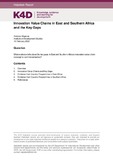| dc.description.abstract | This review synthesises evidence on key gaps in East and Southern Africa’s innovation value chain (concept to commercialisation), e.g. in health technology, sanitation, clean energy, agricultural technology or bio-innovation. The course of building complex innovation value chains in East and Southern Africa – involving several actors and processes (e.g. idea generation, conversion of ideas into innovative products, and innovation diffusion or commercialization) – is hampered by several gaps and challenges. Some of the common gaps and barriers limiting innovation, private sector investment, and innovation commercialisation (in different sectors) include: lack of capital, i.e. access to affordable finance (short and medium term) for setup, inventory and working capital; weak market knowledge, i.e. lack of country, locality or sector awareness; weak business models or lack of proven commercial business models; lack of skills including on how to prepare projects; limited logistics, i.e. lack of infrastructure, logistics and supply chain partners makes delivery and supply of goods challenging and/or expensive; low customer demand – including lack of awareness, low rural purchasing power and expenditure; and inadequate regulation/policies and fiscal barriers, including high import costs and unfavourable tariff policies (BRILHO Business Case, 2016). The report is structured as follows. Section 2 briefly discusses the concept of innovation value chains, key development actors it involves, as well as the major gaps and challenges facing innovation in East and Southern Africa. Sections 3 and 4 present case studies of country programmes (from East Africa and Southern Africa, respectively) that support innovation value chains in different sectors. While discussing each programme, the report summarizes evidence on innovation, commercialization, value chains, inclusiveness, programme impact, gaps and challenges. | en |

